Toyota RAV4
Rear Brake Pads Replacement Guide
How to change the rear brake pads on a
5th generation 2019 to 2023 Toyota RAV4 with the EPB system.
By Paul B. Michaels Author & Photographer Auto Mechanic Since 1989 |
||
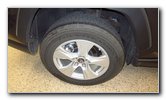 2019 RAV4 Rear Wheel |
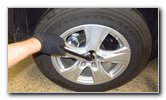 Slightly Loosen Lug Nuts |
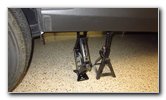 Raise Rear of Vehicle |
| This automotive
maintenance tutorial was specifically written to assist owners of the fifth
generation (2019, 2020, 2021, 2022 and the updated 2023 model year) Toyota
RAV4 SUV with the EPB (electric parking brake) system in changing the rear disc brake pads. Plus directions for
replacing the rotors if necessary. Owners of other Toyota and Lexus vehicles such as the Camry, Corolla, Highlander, Prius, Avalon, C-HR, GR86, Venza, Sienna, Sequoia, 4Runner, IS 250, IS 300, IS 350, ES 350, GS 350 and GX 460 may also find these DIY instructions to be helpful. A few compatible replacement sets of new rear brake pads with their part numbers are as follows: Raybestos EHT1805H, Power Stop Z23-1879, ACDelco Gold 17D1805CH and Akebono ACT1879. The tools and other items needed to complete this procedure include a lug nut wrench, a floor jack, two jack stands, a 14mm socket with a 3/8" drive ratchet, an "F" clamp and a tube of brake parts lubricant grease. Warning: If your RAV4 is equipped with the EPB (electronic parking brake) system, you must place the system in "service" or "maintenance" mode by following these steps. Do NOT compress the caliper piston unless the EPB actuator motors have been fully retracted. 1. Turn the engine switch off. If the EPB has been properly placed into "service mode" you'll see the red light on the parking brake button flashing once per second. You'll also see a flashing red (maybe also orange or yellow) "PARK" warning light on the speedometer. You should have also heard the two EPB actuator motors whirring for a few seconds as they winded back to the fully retracted position. To view the full instructions for placing the
EPB into service mode, view this picture - Once the EPB system is in service mode, disconnect the "-" negative cable from the 12V battery. The next steps are to place wheel chocks on both sides of the front tires to help prevent the vehicle from moving. Slightly loosen the five lug nuts by turning them 1/4 to 1/2 turn in the counterclockwise with the tire iron.. Carefully raise the rear of the vehicle with the floor jack and securely support it with at least two jack stands placed under the frame rail. I prefer to only work on one side of the vehicle at a time to keep three tires on the ground for extra safety. |
||
|
|
||
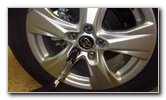 Spin Off Five Lug Nuts |
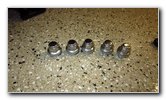 Five Lug Nuts Removed |
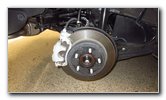 Caliper, Bracket, Rotor |
| Spin off the five
lug nuts and set them aside in a safe place. Carefully pull the rear wheel and tire off to reveal the caliper, bracket, rotor and suspension. Set the wheel aside in a safe place. |
||
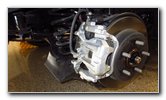 EPB In Service Mode!!! |
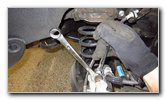 Loosen Top Caliper Bolt |
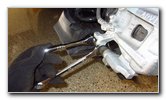 Loosen Bottom Bolt |
|
Warning - Do NOT continue unless
you have placed the EPB (electric parking brake) system into "service" or
"maintenance" mode by following the steps above from the service manual. Please proceed with caution and at your own risk. Disconnect the electrical connector from the EPB actuator motor. Loosen the two caliper bolts by turning them in the clockwise direction (as seen from the outside of the vehicle). If the caliper slide pins move as you are attempting to loosen the caliper bolts, hold them in place with a 17mm wrench. |
||
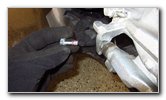 Spin Out Lower Bolt |
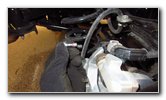 Spin Out Upper Bolt |
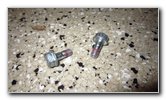 Caliper Bolts Removed |
| Spin out the two
caliper bolts the rest of the way by hand. Set them aside in a safe place. The bolts on this 2019 RAV4 appear to have some red thread locking adhesive on them. Although it is probably not Loctite Red (high strength) since they were easy to remove. |
||
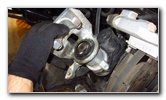 Remove Rear Caliper |
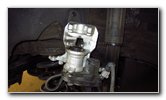 Rest Caliper On Rotor |
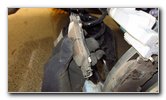 Remove Old Pads |
| Pull the brake
caliper off the old pads and out of the bracket. Rest the caliper on the rotor or suspend it from the spring with a bungee cord. Remove the old inner and outer brake pads from the bracket. |
||
 Wear Bars - Bottom Both |
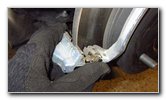 Pad Abutment Clips |
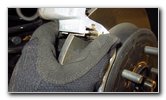 Replace Both Clips |
| On this 2019 RAV4,
there were wear indicator bars or "squeal bars" situated on the bottom of
both the inner and outer brake pads. If your new set of rear pads includes a bag of replacement brake hardware, pull the old pad abutment clips (or "anti-rattle" clips) out of the top and bottom of the bracket. Clean off the rotor, bracket, caliper and lug studs with brake parts cleaner spray. (Do not inhale the fumes!) Apply a thin layer or brake caliper grease to the top and bottom of the new pad abutment clips where they will come in contact with the new brake pads or the bracket. Push the new pad abutment clips in to the top and bottom of the bracket. Do not get any grease on the friction surface of the rotor or the new pads. |
||
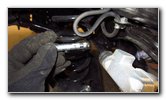 Lubricate Slide Pins |
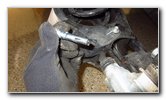 Do NOT Mix Up Pins |
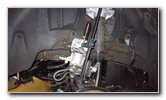 Attach "F" Clamp |
| In order for the
caliper to operate smoothly, the two caliper slide pins (also known as
"slider" or "guide" pins) need to be well lubricated.
Pull out one pin at a time and apply a thin layer of brake parts lubricant grease to the pin before pushing it back into place. Do NOT mix up the two pins. Rotor Replacement Directions If your RAV4 has been shaking, shuddering or vibrating in the rear end while braking, the OEM rotors might be warped and should be replaced. Remove the two 17mm bolts on the back side of the bracket, remove the bracket and set it aside in a safe place. Hit the rotor with a rubber mallet to loosen any rust or spray the back side with penetrating oil. Slide the old rotor off the lug studs. Clean off the new rotor with brake parts cleaning spray. Slide the new rotor over the lug studs. Reattach the bracket with the two 17mm bolts. Tighten the bracket bolts with a torque wrench to the service manual specification of 79 lb-ft (or 107 N*m)of torque. A few compatible replacement rear rotors with their part numbers are as follows: Power Stop JBR1738EVC, Centric 120.44195 and Durago BR90163202. In order for the caliper to fit over the thicker new brake pads, the piston needs to be compressed back. Attach the "F" clamp to the caliper and use the back of an old brake pad to evenly distribute the pressure across the piston. |
||
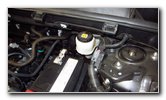 Brake Fluid Reservoir |
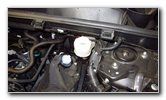 Twist Off Reservoir Cap |
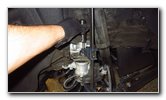 Compress Caliper Piston |
| Move to the right
rear area of the engine bay and twist off the brake fluid reservoir cap in
the counterclockwise direction. Removing the cap will allow the brake fluid to more easily travel back through the lines when you retract the caliper piston. Slowly turn the "F" clamp handle in the clockwise direction to compress back the caliper piston. Repeatedly check the fluid level in the reservoir while you are compressing the piston to make sure it doesn't overflow. Continue turning the "F" clamp handle until the piston is just about flush with the rubber dust boot that surrounds it. Try to avoid pinching or damaging the rubber dust boot. Replace the reservoir cap as soon as you are done retracting the caliper piston. Brake fluid is hygroscopic (absorbs moisture from the air) so the cap should not be left off any longer than absolutely necessary. |
||
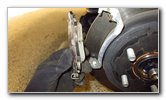 Install New Brake Pads |
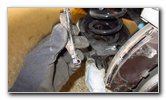 Wear Bar - Bottom Both |
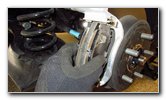 Push Pads Against Rotor |
| Install the new
inner and outer brake pads into the bracket. The wear indicator bars should be located at the bottom of both brake pads. Push pads together until they are flush against the rotor. |
||
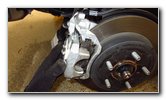 Lower Caliper Over Pads |
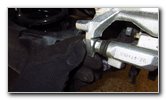 Spin In Bottom Bolt |
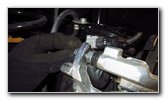 Spin In Top Bolt |
| Carefully lower the
caliper over the pads and into the bracket. Line up the bolt holes in the caliper with their corresponding bolt holes in the bracket. Spin in the caliper bolts a few turns by hand to help prevent them from becoming cross threaded. |
||
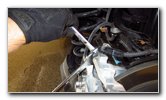 Tighten Top Caliper Bolt |
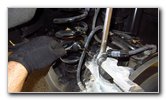 Hold Pin With Wrench |
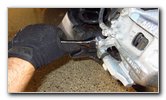 Tighten Bottom Bolt |
| Tighten the two
caliper bolts by turning them in the counterclockwise direction (as seen
from the outside of the vehicle) with the 14mm socket and a 3/8" drive
ratchet until they are snug. If the slide pin turns as you are attempting to tighten the caliper bolts, hold it in place with a 17mm wrench. The service manual specification for tightening the 14mm rear caliper bolts is 25 lb-ft (or 34 N*m) of torque. |
||
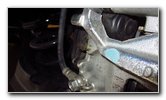 Rubber Valve Cap |
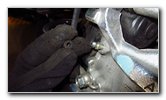 Brake Fluid Bleeder Valve |
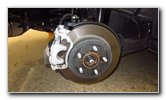 Rear Caliper Secured |
|
If your brake pedal has been feeling soft or "spongy", you probably need to bleed the brake lines in order to remove any air bubbles or moisture. Check out my Acura MDX Brake Fluid Bleeding Guide for some general information on this procedure. The brake fluid bleeder valve is located just below the top caliper bolt. You'll need an 8mm wrench to open and close the bleeder valve. Double check that the caliper bolts, bracket bolts and bleeder screw are tight before moving on to the next steps. |
||
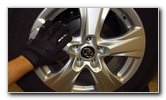 Replace Rear Wheel |
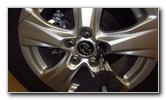 Spin On Five Lug Nuts |
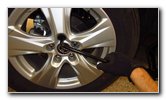 Slightly Tighten Lug Nuts |
| Push the rear wheel
back into place over the lug studs.
Spin on the five lug nuts a few turns by hand in the clockwise direction to make sure they don't become cross threaded. Slightly tighten the lug nuts in the clockwise direction in a "star" or a "criss-cross" pattern with the lug nut wrench. |
||
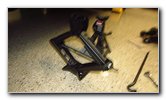 Lower Car From Stands |
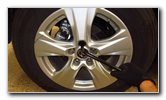 Torque Lug Nuts |
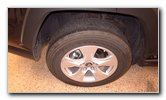 Rear Brake Job Done! |
|
Carefully lower the car from the two jack stands by using the floor jack. Continue progressively tightening the lug nuts in a star or criss-cross pattern to about 1/4 turn past hand tight. The owner's manual specification for the lug nuts is 76 lb-ft (103 Nm) of torque. It would be best to use a torque wrench to properly tighten the lug nuts. Check the brake fluid level in the reservoir and slowly add more DOT 3 or DOT 4 brake fluid if necessary until the level reaches the "MAX" (maximum) line. Sit in the driver's seat and firmly pump the brake pedal a few times to restore the brake line pressure. Reconnect the negative cable to the 12 volt car battery. To exit the EPB service mode, turn the ignition to "ON" but do not start the engine. Then pull up on the EPB button and hold it until you hear the parking brake actuator motors spinning back into place. Here are the service manual instructions for exiting maintenance mode: "(1) After the procedure (rear brake pad replacement, etc.) is complete, turn the engine switch on (IG) and pull the electric parking brake switch (integration control and panel assembly) to the lock side for 5 seconds or more." Be sure to write down the brake pad change in your vehicle's service records. It would be a good idea to check your driveway, garage or parking spot for fresh drops of brake fluid during the next few days which indicate a leak from the reservoir or a bleeder valve. I also recommend verifying that your lug nuts are still properly tightened after your next trip. For more, please check out all of my
2019-2023 Toyota RAV4 DIY Repair & Maintenance Guides. |
||
| If you found this guide to be helpful,
please consider making a small donation by clicking on the PayPal.com
"Donate" button located to the right of this paragraph. Thank you!
(Note: I am not a registered charity. Donations are not tax deductible.) |

